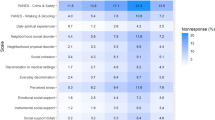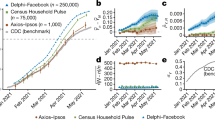Abstract
We used estimates derived from screener variables of the National Human Exposure Assessment Survey (NHEXAS) Phase I field study in EPA Region V (one of three NHEXAS Phase I field studies) to examine biases resulting from survey nonresponse and/or incomplete population coverage inherent in the study design. For variables with population values obtainable from Census projections, the combined effect of nonresponse and coverage bias was tested for after each stage of nonresponse using design-based weights. For variables where population values were not available as Census projections, nonresponse bias was tested for after the screener stage of nonresponse using weights adjusted for screener nonresponse. Additional tests for bias were performed using final survey weights to evaluate the performance of survey weight adjustments in reducing observed bias. Comparison of biases estimated using both design-based and adjusted weights was used to identify potentially important weight adjustment variables for future exposure studies, identify possible weaknesses in survey design strategies, and support the use of nonresponse and poststratification weight adjustments to reduce bias in future survey studies.
This is a preview of subscription content, access via your institution
Access options
Subscribe to this journal
Receive 6 print issues and online access
$259.00 per year
only $43.17 per issue
Buy this article
- Purchase on Springer Link
- Instant access to full article PDF
Prices may be subject to local taxes which are calculated during checkout
Similar content being viewed by others
Notes
These bounds on the bias are obtained using the identities p=ηpNR+(1−η)pR where p is the overall population prevalence (mean), pNR is the prevalence among nonrespondents, pR is the prevalence among respondents, and η is the nonresponse rate, and Bias=pR−p.
It is expected that the projections are more precise than the estimated distributions obtained in this paper. The projections are relatively near-term (5 years forward), and are averaged over several relatively slow growing states.
References
Benjamini Y., and Hochberg Y. Controlling the false discovery rate: a practical and powerful approach to multiple testing. J R Stat Soc B 1995: 57: 289–300.
Callahan M.A., Clickner R.P., Whitmore R.W., Kalton K., and Sexton K. Overview of important design issues for a national human exposure assessment survey. J Expos Anal Environ Epidemiol 1995: 3: 257–282.
Cox B.G., Mage D.T., and Immerman F.W. Sample design considerations for indoor air exposure surveys. J Air Pollut Control 1988: 38: 1266–1270.
Folsom R.E. Exponential and logistic weight adjustments for sampling and nonresponse error reduction. Proc Amer Stat Assoc Soc Stat Sec 1991, pp. 197–202.
Genovese C., and Wasserman L. Operating characteristics and extensions of the false discovery rate procedure. J R Statist Soc B 2002: 64: 499–517.
Kass G.V. An exploratory technique for investigating large quantities of categorical data. Appl Statist 1980: 29: 119–127.
Little R.J., and Rubin D.B. Statistical Analysis with Missing Data. John Wiley & Sons, New York, 1987.
Rao J.N.K., and Scott A.J. The analysis of categorical data from complex surveys: chi-squared tests for goodness of fit and independence in two-way tables. J Am Statist Assoc 1981: 76: 221–230.
US EPA. Survey management handbook, Volume I: Guidelines for planning and managing a statistical survey. EPA-230/12-84-002. Office of Policy, Planning and Evaluation, Washington, DC, 1983.
Whitmore R.W., Byron M.Z., Clayton C.A., Thomas K.W., Zelon H.S., Pellizari E.D., Lioy P.J., and Quackenboss J.J. Sampling design, response rates, and analysis weights for the National Human Exposure Assessment Survey (NHEXAS) in EPA Region 5. J Expos Anal Environ Epidemiol 1999: 9: 369–380.
Acknowledgements
The United States Environmental Protection Agency through its Office of Research and Development funded and collaborated in the research described here under Contract Number 68-D-99-008 and assistance Agreement Number CR821902 to Research Triangle Institute. It has been subjected to Agency review and approved for publication. We thank C.A. Clayton for preparation of the statistical analysis database. Mention of trade names or commercial products does not constitute endorsement or recommendation for use.
Author information
Authors and Affiliations
Corresponding author
Rights and permissions
About this article
Cite this article
Mosquin, P., Whitmore, R., Suerken, C. et al. Population coverage and nonresponse bias in a large-scale human exposure study. J Expo Sci Environ Epidemiol 15, 431–438 (2005). https://doi.org/10.1038/sj.jea.7500421
Received:
Accepted:
Published:
Issue Date:
DOI: https://doi.org/10.1038/sj.jea.7500421



